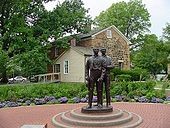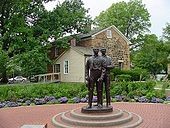Carthage Jail
Introduction
Text-to-speech Audio
Built in 1839, this two-story jail housed petty thieves and debtors and occasionally also held men charged with violent crimes before they were transported. In addition to a cell on the second floor and a debtor's room found on the first floor, the jail also had a kitchen, dining room. and bedrooms for the guards. The jail is most famous today as the site of the killing of Joseph Smith and Hyrum Smith on June 27, 1844.
Images
Statue of Joseph and Hyrum Smith located in front of jail.


Backstory and Context
Text-to-speech Audio
In 1844, the jail was used to hold LDS founder and prophet Joseph Smith, his brother Hyrum and two apostles of the Church: John Taylor and Willard Richards. They were ordered by the Governor of Illinois to go to the jail in Carthage to await trial. The men were being charged with treason and disturbing the peace. The charges were later discovered to be bogus, designed by an anti-Mormon contingent from Missouri, the state that issued the infamous 'extermination order' against the Mormons.
June 27, 1844, while preparing for court, a mob of about 150 men surrounded and stormed the jail. The 'prisoners' were located on the second floor. Hyrum was killed first, followed by Joseph, whose body fell out of the window and landed near the well adjacent to the jail. John Taylor was severely wounded but survived. Willard Richards only received a nick on his ear.
The mob fled when it was reported that a group of Mormons was coming to rescue the four men. The latter would retrieve the bodies and return them to the nearby city of Nauvoo, built by the Church. Rather than ending the growth of the LDS Church with Joseph's death, as the mob had hoped would happen, Brighman Young succeeded Joseph and led Church members to modern-day Salt Lake City, UT, starting in 1846.
Joseph Smith and Hyrum are buried in Nauvoo. Visitors can visit the town of Nauvoo as well as Carthage.
Sources
http://en.wikipedia.org/wiki/Carthage_Jail http://www.greatriverroad.com/quincy/carthagejail.htm
